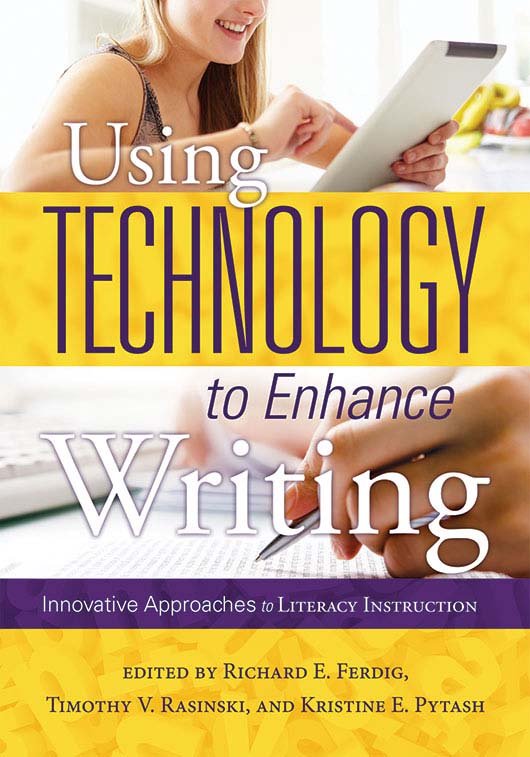Free Reproducibles
Using Technology to Enhance Writing
Innovative Approaches to Literacy Instruction
Sharpen your students' communication skills while integrating digital tools into writing instruction. Loaded with techniques for helping students brainstorm, plan, and organize their writing, this handbook troubleshoots issues students face when writing in a printed versus digital context and teaches them how to read in multiple mediums. You'll find tips for sharing writing, getting interactive feedback, incorporating grammar instruction, and more.
Benefits
- Leverage digital technology to facilitate grammar instruction, prewriting and brainstorming exercises, editing, revising, peer review, assessment, and more.
- Discover how the natural interplay between reading and writing can strengthen both of these processes.
- Help students move writing through multiple storage locations and technologies—from school computers and smartphones to laptops and tablets.
- Develop students' understanding of voice, audience, and the responsibilities of authorship.
- Examine the process of not just fixing mistakes, but also understanding the root issues that drive errors.
TABLE OF CONTENTS
Part I: Prewriting and Introduction to Writing
Chapter 1: Driving Without a License: Digital Writing Without Digital Citizenship
Chapter 2: The Language Experience Approach Goes Digital
Chapter 3: Integrating Expository Writing With Technology
Part II: The Reading and Writing Connection
Chapter 4: Fostering Deep Engagement With Malleable Digital Genres
Chapter 5: Reading for Tone and Writing With Expressive Voice
Chapter 6: Digital Reading Logs: A Third Space for Literacy Growth
Part III: The Process Approach
Chapter 7: Screencasts: The Integration of Reading, Writing, and Technology
Chapter 8: Digital Storytelling
Chapter 9: Digital Writing Workshop
Part IV: Awareness of Audience and Purpose
Chapter 10: Electronic Family Message Journals
Chapter 11: Blogging and the Tool of Storytelling
Chapter 12: Engaging the Okal Rel Universe
Part V: Collaborative Writing
Chapter 13: Using Technology for Collaborative Writing
Chapter 14: Digital Content Curation
Chapter 15: The 4E Wiki Writing Model
Part VI: Grammar Instruction
Chapter 16: Data-Driven Learning for Grammar Classrooms
Chapter 17: Writing Pattern Poetry on Facebook
Chapter 18: Visual-Syntactic Text Formatting
Part VII: Editing and Revising
Chapter 19: Using 21st Century Technology to Edit and Revise
Chapter 20: Peer Review in a Digital Space
Chapter 21: Effective Revision and Editing Strategies
Part VIII: Assessment
Chapter 22: Automated Essay-Scoring Software
Chapter 23: Authentic Writing Through Digital Feedback
Chapter 24: Measuring Student Growth With Digital Portfolios
Reproducibles and Resources
Chapter 1
Web Resources
- Common Core State Standards Initiative, "Standards”
- Digital ID
- Digital ID, "Focus 1—Stepping Up”
- Digital ID, "Policy Resources”
- Digital ID, "Student-Created Content”
- Google Docs
- National Writing Project
- #UnfollowBullying
Chapter 2
Reproducibles
- Feedback Form for Students
- Language Experience Approach (LEA) Checklist for Intermediate or Advanced EL Students
- "What Did They Do on Mother's Day in This Home?”
Web Resources
Chapter 3
Web Resources
Chapter 4
Web Resources
Chapter 5
Chapter 6
Web Resources
- Google Drive
- Microsoft Word
- Moms' Return to Work Soon After Having Children/li>
Chapter 7
Web Resources
Chapter 8
Web Resources
- Dr. Helen Barrett's Electronic Portfolios, "Digital Storytelling”
- Educational Uses of Digital Storytelling
- Flickr
- iMovie
- Microsoft Photo Story 3
- Movie Maker
- Pdsounds
- SoundBible
Chapter 9
Web Resources
- Blackboard
- Blogger
- Digital Sandbox
- Digital Writing, Digital Teaching
- Edmodo
- Edublogs
- Google Docs
- Kidblog
- Moodle
- Schoology
- Typing Agent
- Weebly
- Wikispaces
Chapter 10
Web Resources
Chapter 11
Web Resources
Chapter 12
Web Resources
Chapter 13
Web Resources
- Cacoo
- Etherpad
- Florida Institute for Human and Machine Cognition CmapTools (1 of 2)
- Florida Institute for Human and Machine Cognition CmapTools (2 of 2)
- Google Drive
- Google Docs
- Google Maps
- Google Sites
- Lucidchart
- MeetingWords
- Microsoft OneDrive
- MindMeister
- PiratePad
- Popplet
- Prezi
- PrimaryPad
- PrimaryWall
- TitanPad
Chapter 14
Web Resources
- Blendspace
- Edmodo
- eduClipper
- Evernote
- Feedly
- Instapaper
- Learnist
- LiveBinders
- Padlet
- YouTube
Chapter 15
Web Resources
Chapter 16
Web Resources
- AntConc
- British National Corpus
- Corpus of Contemporary American English
- Geoffrey Sampson, "LUCY Corpus”
- Just the Word
- Longman Dictionary of Contemporary English
- Time Magazine Corpus
- Wordsmith Tool
Chapter 17
Web Resources
Chapter 18
Web Resources
Chapter 19
Reproducibles
Web Resources
Chapter 20
Web Resources
Chapter 21
Web Resources
Chapter 22
Reproducibles
- Automated Scoring Resources
- Introductory Vignette: The Time for Technology in the Writing Classroom Is Now
- Extension/Sample Automated Essay Scoring Software
Web Resources
- Educational Testing Service
- Holt, Rinehart and Winston, "Holt Online Essay Scoring: Teacher Support”
- Kansas Assessment Program
- LightSide
- Partnership for Assessment of Readiness for College and Careers
- Pearson, "Free Essay Scoring”
- Riverside Publishing
- Riverside Publishing, "Criterion Online Writing Evaluation”
- Smarter Balance Assessment Consortium
- Vantage Learning
- Yahoo! Finance, "Houghton Mifflin Harcourt Announces Cutting-Edge Common Core English Language Arts Curriculum, Collections ¬©2015”
Chapter 23
Reproducibles
Web Resources
Chapter 24
Reproducibles
Web Resources

